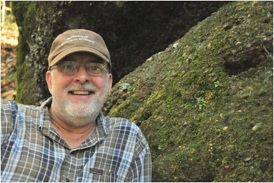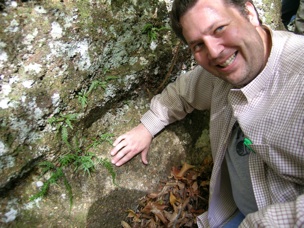Committee:
John Manion (Chair): Birmingham Botanical Gardens
Brian Keener: University of West Alabama
Wayne Barger: Alabama Department of Conservation and Natural Resources
Evan Kilburn
Richard and Nancy Cobb
Junter McBrayer
Among the rarest of Alabama’s endemics, Tutwiler’s spleenwort (Asplenium tutwilerae) is known from a single, small population in Hale County, where it grows in a shaded ravine on a type of conglomerate stone known as puddingstone. The photo above right shows Brian Keener, who along with Larry Davenport corrected the species’ name and discussed its hybrid origin in 2007, along with some plants growing in their typical style on the side of a rock face. The photo top left shows the Committee Chair, John Manion, with several small ferns visible on the rock to the right side of the photo.
This relatively diminutive fern was only recently described by botanists as a fertile hybrid species. It developed through a type of speciation known as reticulate evolution, in which the offspring of the two parent species (Asplenium platyneuron, ebony spleenwort, and A. rhizophyllum, walking fern) are fertile and reproduce true to type, as opposed to creating a “one-time” sterile hybrid. The population was first written up by Julia Tutwiler, one of Alabama’s education pioneers and an amateur botanist, in 1873, and the fern is named in her honor. John Manion, Kaul Wildflower Garden curator at Birmingham Botanical Gardens is leading the Alabama Plant Conservation Alliance’s task force for this plant. The committee is especially grateful to members Richard and Nancy Cobb, who have monitored this population for several years and have guided botanical enthusiasts to the site.


